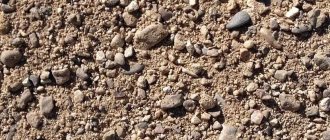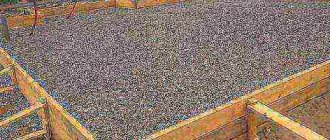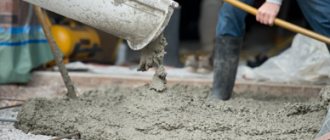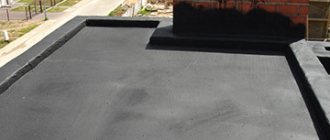Home |Construction |How to make a pillow for the foundation with your own hands?
Date: June 13, 2017
Comments: 0
The foundation of a building is the main structural element that determines the stability of the building and ensures a long service life. The foundation of the building bears serious loads associated with the characteristics of the soil and the number of storeys of the building. In order to increase reliability and ensure minimal shrinkage, a foundation cushion is formed based on various materials. It is the basis of the foundation and increases the stability of the construction site intended for the construction of the structure. Experts pay special attention to the material of the bottom layer, the choice of which depends on many factors.
Let us dwell in detail on the purpose and types of pillows. Let's consider the construction of a foundation cushion made from various building materials. Let's figure out how to make your own sand cushion for the base of a building being built.
The foundation for the construction of any building is a very important object on which the durability of the future building depends
What is and why do you need a foundation cushion?
Any type of foundation must be installed on a previously prepared construction site. To do this, using various technologies and materials, a basic level of foundation is formed that performs the following functions:
- compensation of soil reaction associated with soil heaving;
- leveling unevenness of the construction site;
- increasing the stability of the base;
- reducing shrinkage of the structure;
- protection against moisture penetration;
- uniform distribution of the load from the building to the soil.
Varieties
Depending on the requirements of the previously developed detailed design of the building, the following materials are used in the construction industry to form the lower level of the foundation:
- Sand.
This is a budget option for the material used in the construction of the base of light one-story buildings made of wood or frame structures. The minimum thickness of the bedding at the level of 25–30 cm is capable of reliably protecting the base of the building, according to its functional purpose.
It's no secret that a poorly laid foundation will make life in the house impossible.
- Crushed stone.
The increased strength of the crushed stone fraction allows the material to be used in the formation of foundation cushions intended for the construction of buildings up to two floors high. Crushed stone proportionally distributes the operating loads over the entire area, subject to uniform compaction. - Concrete.
Provides maximum strength when constructing the foundation of a building. It is superior to sand and crushed stone in terms of reliability, but is the most expensive option for forming a base layer. Allows you to bear the load from multi-story buildings, compensates for the reaction of problematic soils prone to frost heaving.
When choosing a specific pillow for the future foundation of the structure, you should analyze a set of factors, the main of which are:
- number of floors of the building;
- type of soil;
- level of location of aquifers;
- materials used for the construction of the building;
- climatic conditions of a particular area.
When determining the design of the pillow under the foundation, it is necessary to carefully study its features and analyze a set of factors. Let's take a closer look at each of the options.
To level the bottom of a trench or pit at the site of the future foundation, it is necessary to fill in a ten-centimeter layer of sand or gravel
Construction
Preparation
The instructions for constructing a concrete preparation for a foundation or finishing screed are more than simple.
- The bottom of the pit or trench is leveled and compacted as much as possible.
- On soils of moderate density and heaving soils, sand bedding about 10 cm thick is used . The sand is spilled with a large amount of water for maximum shrinkage. On dense sandy loam and sandy soils, bedding is not needed; on a rocky base, for obvious reasons, the pillow itself is not needed.
- A layer of waterproofing is spread over the bedding (usually strips of dense polyethylene with a 10-centimeter overlap).
- A layer of concrete (without reinforcement) 100 mm thick is laid over the waterproofing . The minimum permissible strength grade of concrete, according to SP 50-101-2004, is M50. Usually M100 is used, the price of a cube is even slightly lower due to the use of coarse aggregate (only solutions with strength M50 are produced).
Grade M100 allows the use of coarse aggregate made from sedimentary rocks. Hence the minimum cost.
When preparing your own concrete mixture, you can use the table of proportions:
Sand cushion for the foundation
The construction of a sand-based foundation is characterized by low costs and ease of formation. The use of sand mass with large particle sizes and its careful compaction in a moistened form ensures the required performance characteristics.
The sand cushion under the foundation is used:
- On construction sites under which groundwater is located at a sufficient depth. When performing work on an area with nearby groundwater, it is imperative to form a drainage system under the sand massif. It will protect the compacted sand from washing away.
- When constructing the base of buildings whose walls are made of lightweight cellular materials or frame structures. With an increased density of the wall material, the load on the base increases and the use of compacted coarse sand does not provide the desired effect. The scope of use is limited to one-story buildings.
An increase in the load-bearing capacity of the sand mass is ensured by careful compaction, which increases the density of the bedding layer.
A sand cushion for the foundation is the simplest and cheapest type of bedding, so it is chosen by those who want to save money, speed up the construction process and do it themselves
Factory products
Concrete foundation pads for FBS are also manufactured at enterprises. Externally, their shapes resemble trapezoids. Such blanks are considered an excellent option as a base poured in front of the foundation during the construction of a heavy stone structure.
The cost of ready-made concrete products is quite high.
These pillows can be installed quickly:
- the ground is leveled;
- a layer of sand is poured, the height of which reaches half a meter, taking into account the characteristics of the soil composition;
- reinforced concrete blocks are installed.
Gravel foundation pad
The increased strength characteristics of the gravel base make it possible to use it in the construction of massive buildings. Optimal performance characteristics of a gravel massif are ensured by using material with a fraction size of 2–4 cm. When forming foundation bedding based on gravel, work is performed in the following order:
- Coarse sand is poured in, forming a bedding layer up to 15 cm thick.
- The surface of the sand massif is planned.
- The litter is compacted using special vibration equipment.
- Crushed stone is poured and evenly distributed over the surface in a layer of 25–30 cm.
- A layer of crushed stone is compacted to increase its load capacity.
- The horizontal surface of the crushed stone mass is controlled using a building level.
When forming a crushed stone bedding, it is important to ensure that its dimensions exceed the dimensions of the base by 0.5 m. This will increase the stability of the structure being built.
This base has a clear advantage over the previous one - it is stronger and more durable, since gravel acts as the main component here
Calculation of the amount of material for arranging a crushed stone cushion
To determine the consumption of bulk material, it is necessary to know the volume of the substrate and the weight of the fraction involved. This indicator can be viewed either in the quality certificate, or you can use the general average value. The latter is 1450 kilograms per cubic meter. One ton of crushed stone fills a volume equal to 0.67 cubic meters. It is enough to divide the volume of the pillow by this parameter. The result is the required amount of crushed stone.
If it is possible to find out the exact weight of the fraction, the calculations will be more accurate. In addition, it is necessary to take into account the fact that the pillow is most often equipped with a combination pillow, which means that part of the volume will be taken up by river sand. Its consumption will increase when replacing the top layers of problematic soil. It is better to order bulk materials with a margin of 10-20 percent. Otherwise, you will have to make additional purchases later. We should not forget that crushed stone is also used for the foundation, so it will be needed more than just for a pillow.
Monolithic slab on a concrete pad
A foundation based on a concrete layer has increased load-bearing capacity and can be installed on various soils for the construction of multi-story buildings. The technology for forming the lower concrete layer involves the following operations:
- Construction of a crushed stone base with a layer thickness of up to 15 cm.
- Vibration compaction of the formed array.
- Installation of wooden formwork around the perimeter of the concrete layer being created.
- Control of the height of a conventional frame corresponding to the zero level of the base.
- Reinforcement of the concrete layer using steel rods with a diameter of 0.8–1.2 mm.
- Connecting the reinforcement with tying wire with an interval between the rods of 15–20 cm.
- Concreting the formwork and further vibrating compaction to remove air bubbles from the concrete mass.
- Planning the concrete surface according to the frame level.
- Periodic moistening with water and protection from cracks with plastic film.
Compliance with the technology of creating a concrete layer ensures the reliability of the constructed foundation.
This design has only one drawback - its high cost, but otherwise such a project consists of continuous advantages
Intermediate layer thickness
Construction of a monolithic base
The height of the pillow is always taken after performing the design calculation. To do this, specialists do geological surveys of the soil in the construction region and find soil characteristics. At the sole mark, the average pressure on the ground is perceived, therefore, due to compaction, this force will be less. The load will be taken by the natural base, so the correct choice of layer thickness will prevent the possibility of deformation.
Recommended layer thickness:
- sandy base - 15 - 60 cm;
- crushed stone backfill – 20 – 70 cm:
- concrete monolith - 25 - 50 cm;
- prefabricated elements - 30 - 50 cm.
The thickness of the layer can be reduced through the use of geotextile fabric, which will prevent moisture from entering the base. Combining pillow materials also helps to reduce the size.
How to make your own sand-based pillow
Let's consider how to make your own sand bedding, which allows you to reduce the estimated cost of construction. To complete the work, complete the preparatory steps:
- Mark the construction site using a cord and pegs.
- Remove vegetation and construction debris.
- Remove the soil by forming a pit to the required depth.
- Level the soil surface.
- Lay geotextiles on the base of the soil to protect the array from moisture.
- Prepare and deliver coarse river or quarry sand to the work site.
Having carried out a set of preparatory work, you can backfill the sand base and compact it.
Nomenclature series
You can select the types of blocks required for construction using the standard table. The product range is extensive. For each type, markings, geometric dimensions, and the need for reinforcement and concrete are indicated.
FL grade slabs for prefabricated strip foundations
The shape, dimensions and reference weight are given in Table 1:
Table 1. Shape, dimensions and reference weight of slabs
In accordance with the requirements of the project of the building being constructed, with a block height of 30 or 50 cm, you can choose products of any required dimensions:
- length – from 0.78 to 3 meters;
- width from 0.6 to 3.2 meters.
The slabs differ in the shape of the side surface, which is flat for a width of 0.6 meters, and stepped for products with dimensions from 0.8 to 3.2 m. For transportation and installation, special lifting equipment is required, since the weight of the lightest blocks is about 400 kilograms, and the heaviest ones are about 6 tons.
Backfilling and compacting the sand cushion
The sand layer under the foundation is formed as follows:
- Build drainage for nearby groundwater.
- Pour coarse sand over the entire area.
- Form a layer of litter 20–25 cm thick.
- Ensure the surface is horizontal.
- Compact the layer of sand with a vibrating plate, moistening it generously with water.
A sand cushion under a strip foundation saves the base from erosion and also ensures a permissible load on its lower part
Please note that the degree of compaction of the sand layer should be such as to eliminate shoe marks on the sandy surface. After filling the sand and completing its compaction, proceed with the construction of the foundation provided for by the requirements of the project.
Formwork installation
After all the corners of the future foundation are accurately marked and checked more than once, you can begin installing the formwork. To ensure that the boards are held firmly and do not move, they can be fixed using U-shaped brackets.
The formwork must be installed so that the walls of the base itself are exactly in the center of its cushion. When erecting the formwork, be sure to check the right angle at the intersection of the extreme corners of the foundation.
If, when joining boards, large gaps appear in some places, they can be closed by laying a small board and nailing them down. You should not pay attention to the appearance of the pillow, since due to the unevenness of the formwork it may not be completely level. The most important thing is compliance with the calculated indicators and ensuring strength.
When the installation of the formwork is completed, it is advisable to pour a little soil into its weak spots. As a rule, these are the joints of individual boards. Thanks to this, the concrete solution will not seep under the formwork.
Sand cushion for the foundation - advantages
The positive features of the sand base foundation are:
- availability of building materials, stocks of which are available in all regions;
- reduced costs associated with the purchase of inexpensive material and the formation of the base layer;
- ease of work, allowing you to independently prepare the site for the foundation;
- compensation of compressive loads acting from the mass of the structure being erected;
- reduced degree of thermal conductivity, reducing heat loss;
- high degree of compaction due to the size of the sand fraction and increasing strength;
- uniform distribution of acting loads;
- preventing moisture from rising from the soil by capillary action;
- planning the unevenness of the landscape, facilitating the construction of the foundation.
The disadvantages include the impossibility of constructing massive multi-story buildings built on soils with closely spaced aquifers.
Functional meaning
Any structure exerts some kind of load on the ground. So that it does not sag and the load is distributed evenly, a mineral foundation cushion is placed over the entire supporting area. In addition, the following issues are resolved:
- the construction site is leveled;
- compensates for soil movement during seasonal changes;
- a protective barrier is installed against the direct impact of soil on the foundation;
- the level of soil stability increases, which is especially important for seismically unstable regions;
- a drainage system is provided to remove melt and rainwater from the building.
This or that execution is determined by the state of the working site. This is the type of soil, indicators regarding groundwater, and climatic conditions of the area. The material and design features of the structure being built are also taken into account. The base can consist of sand, gravel and crushed stone, with a dry concrete screed. Before casting the foundation, the cushion is compacted while maintaining a horizontal level.
Tamping machine Source static.tildacdn.com











